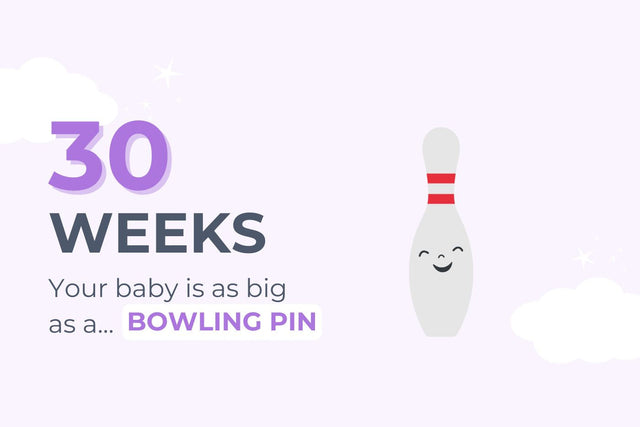30 Weeks Pregnant: Ways to Help That Back Pain

On This Page
Your Baby at 30 Weeks
It’s likely your baby is kicking a little less these days, but don’t panic. Your baby-to-be is beginning to outgrow the “womb-room” they rented. (It's getting pretty tight to maneuver in there!) Your bub growing fast—weighing about 3 pounds now—and they’ll gain about a half pound per week until...their lease is up!
Your bub's head, which was previously so much larger than their body, is now in proportion. And, if you shine a dull or red light at your belly, they just might turn to look at it (and turn away from a very bright light)! Your baby-to-be's vision is about as clear now as it will be at birth, but still extremely nearsighted by our standards (about 20/400). In their first week of life, your baby will be especially interested in looking at things that are red or have strong contrast. (That’s why infants like looking at black-and-white white patterns…and the line where your face meets your dark hair or the contrast of your eyes.) Your bub's best vision is 9 to 18 inches away…which is perfect, because that’s exactly the distance between your face and theirs while feeding. Read up on your baby's vision development!
Size of Baby at 30 Weeks Pregnant
At 30 weeks, your baby is as big as a bowling pin—appropriate, as they have increasingly less room to spare!
30 weeks pregnant is how many months?
30 weeks pregnant is approximately 6 months and 2 weeks into pregnancy.
30 Weeks Pregnant: What to Expect
Right about now, your baby may start putting serious pressure on your lower back. Your amazing body will make several adjustments to handle the extra weight. For example, your spine will curve more, which shifts your center of gravity and prevents you from…toppling over!
Because of this, back pain is a common 3rd trimester symptom. Wearing a belly support band, massage, acupuncture, gentle stretching, and exercise like swimming may lessen pain. (Learn more about easing pregnancy back pain.)
It’s possible your tailbone (called your coccyx) is hurting, too. It is made up of three to five semi-fused bones connected by disk-like ligaments sitting right at the bottom of your spine. To feel better, try gentle movement like swimming or walking—and invest in a wedge or donut cushion. But if your pain is severe, talk to your doctor. A physical therapist or pelvic floor specialist can recommend exercises, like pelvic tilts and cat/cow pose, to help. The good news is that tailbone troubles usually resolve after the birth.
30 Weeks Pregnant Symptoms
Common symptoms during the 30th week of pregnancy include:
- Bloating and gas
- Difficulty sleeping
- Swelling of the feet and ankles
- Stretch marks
- Constipation
- Changes in fetal movement
30 Weeks Pregnant To-Do List
-
Shop for yourself: Get anything you think may make life easier for after the baby comes. Some parents-to-be develop hemorrhoids late in pregnancy (and they can get much worse during labor), so Tucks pads or another kind of witch hazel wipe are good to have on hand. Many folks swear by stool softeners (like prune or aloe vera juice) to ease the discomfort of your first post-baby bowel movement. And everyone needs to stock up on overnight pads—expect bleeding to last six weeks. Learn more about your postpartum recovery timeline and get more ideas for postpartum care essentials.
-
Get thank you cards and stamps: The gifts will roll in. Keep your notes short and sweet…everyone knows how busy new parents are! Also know that text thank yous are A-okay, too! (Get thank you note writing tips.)
-
Research breastfeeding pillows: If you are planning on nursing, you’ll need breastfeeding support—figuratively and literally. Popular pillow options include the Boppy, My Brest Friend, and Luna Lullaby. Whatever you choose, make sure it’s sturdy enough to let you feed without slumping over, which may cause back, shoulder, and neck pain.
-
Save important numbers on your cell: Program the digits for your doctor or midwife (and doula if you are hiring one) into your phone and your partner’s.
Pregnancy Lingo Lesson: Pitocin
Oxytocin is a hormone secreted by the pituitary gland, which is located deep in your brain. Among other things, oxytocin makes muscles squeeze! Later on, it will help the tiny muscles in the milk ducts of your breast squeeze, which causes let down (milk may even spray out of your breast!). Oxytocin also starts and sustains your labor contractions. Interestingly, it’s also called the “love hormone,” because your body produces it during sex. Pitocin is a synthetic form of oxytocin, administered through an IV to help speed up contractions (it’s commonly used with the epidural, which can slow labor). Pitocin may also be given after delivery to contract the uterus and lessen bleeding.
Pitocin has good sides…and bad sides. If your labor is stalling, it can help speed things up. But it can also increase pain by dramatically intensifying labor contractions, which might stress your baby and even require a c-section.
Pregnancy Quote of the Week
If pregnancy were a book, they would cut the last two chapters.— Nora Ephron
29 Weeks Pregnant | 31 Weeks Pregnant